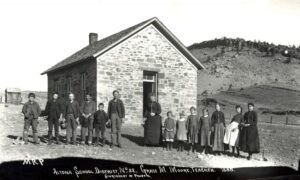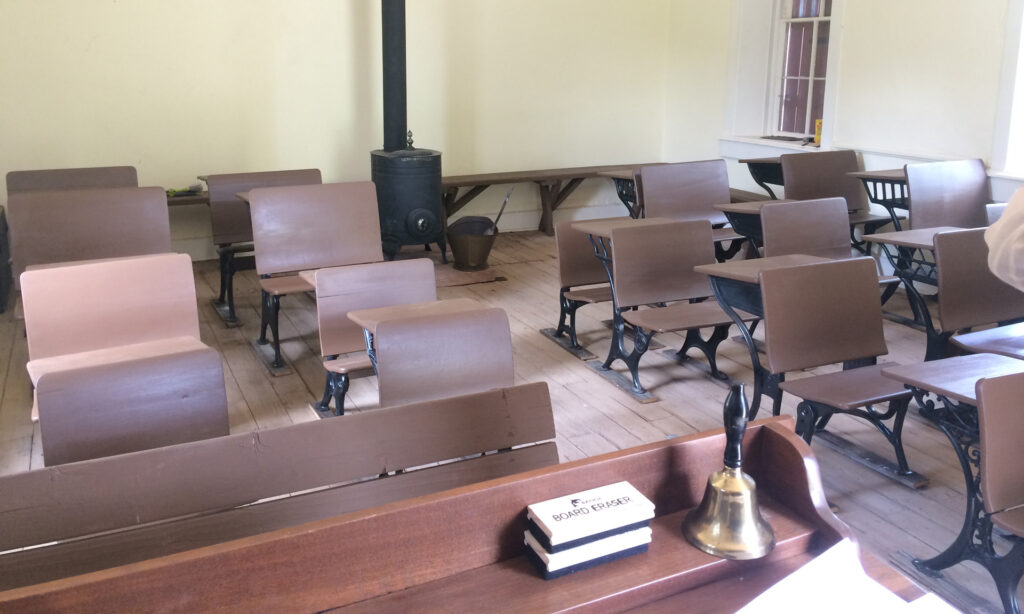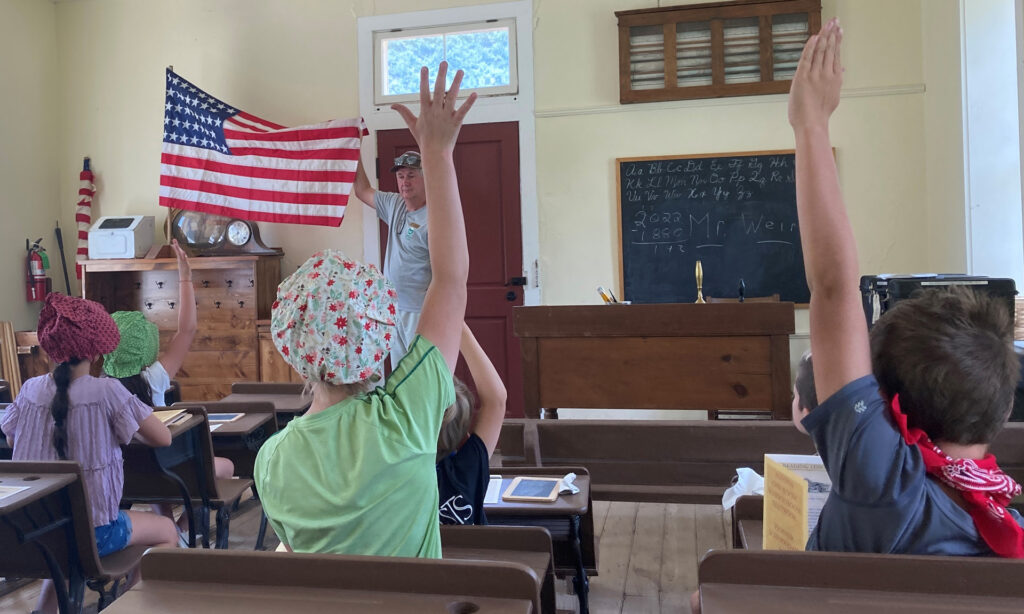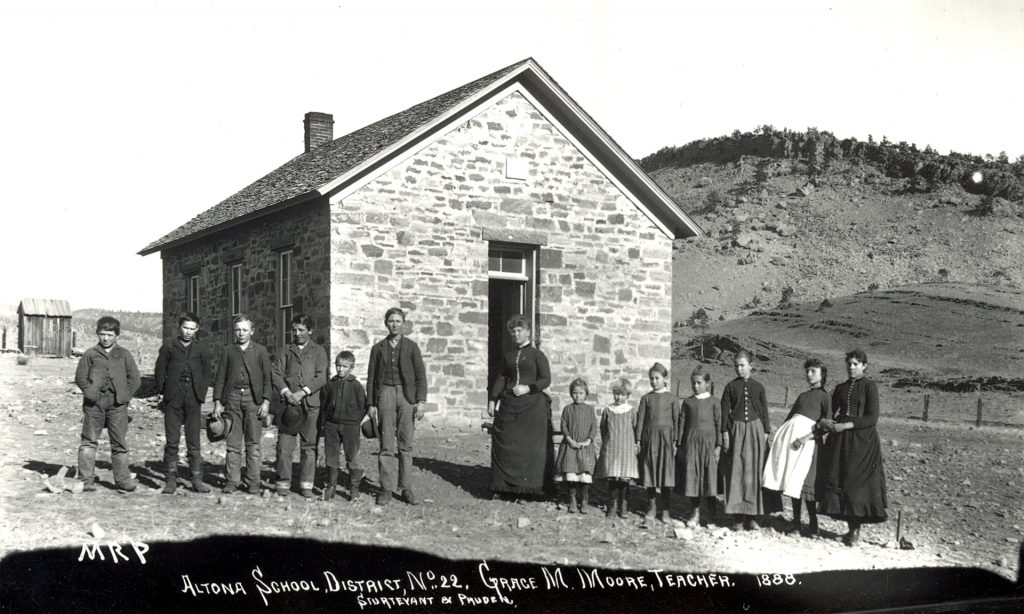Take a visit to the historic Altona Schoolhouse. The one-room country school was built in 1880 and operated into the 1940s. The schoolhouse has been restored and looks much like it did when it was first built.
Altona Schoolhouse
Public Open House
The Altona Schoolhouse is open to the public the second Sunday of the month June through September. Drop by anytime between 11 a.m. and 2 p.m. to go inside the historic schoolhouse where students studied and played from 1880 to the World War II era.
Volunteers will be on hand to share the school’s history and restoration with visitors. If time allows, you can take part in a game or spelling bee.
Park at the Corral Trailhead at Heil Valley Ranch and hike 10 minutes on the Schoolhouse Loop to the Altona Schoolhouse.
- June 9: 11 a.m. – 2 p.m.
- July 14 11 a.m. – 2 p.m.
- Aug. 11: 11 a.m. – 2 p.m.
- Sept. 8: 11 a.m. – 2 p.m.
Schedule a Field Trip
Teachers can schedule a field trip and choose from three program options (each one takes approximately one hour):
- 1880s Pioneer School Day
- 1940s World War II School Day
- Mining History: Explore Boulder County’s gold, silver, and tungsten roots
The schoolhouse comfortably fits a class of about 30 students. If your group is larger, we will split your group so half “attend school” while the other half hikes a nearby trail for the hour, then switch the groups. This option makes for a two-hour program combining natural and cultural history.
Field trips available any day of the week May-October.
- Request a Program or contact Sheryl Kippen, 303-776-8848
Read about the history, watch the videos below, and use the suggested activities to create a fun virtual field trip from anywhere!
This virtual field trip is primarily intended for third and fourth grades, but they are flexible and can be adjusted for the group and time available. It is important that the group read the introduction to the field trip. This could be read aloud to students or by students on their own. That way students will know a bit about the place they are virtually visiting!
History
 Altona School was a one-room country school northwest of Longmont from 1880 to the 1940s. One-room schools usually started in country neighborhoods where many farm or ranch families lived. Education for their children was important, so they would work together to offer school in their homes as more settlers came to their area. When local requirements were met, they could form a school district and would often pool their resources and energy to build a school that the children could attend.
Altona School was a one-room country school northwest of Longmont from 1880 to the 1940s. One-room schools usually started in country neighborhoods where many farm or ranch families lived. Education for their children was important, so they would work together to offer school in their homes as more settlers came to their area. When local requirements were met, they could form a school district and would often pool their resources and energy to build a school that the children could attend.
Communities would hire a teacher to teach grades one (there was no kindergarten then) through eight. Children as young as preschool age (they might be sent to school with an older sibling) and as old as age 20 attended school. Students whose help was heavily needed on their family farms might attend school off and on, so some continued to attend after the age eighth grade typically ended. The teacher, along with help from older students, taught all subjects: reading, writing, arithmetic, as well as subjects they might have special knowledge of, such as science, history, or a foreign language. Every school was a bit different.
If students wanted to attend school beyond the eighth grade, they had to move to a big city and likely stay with extended family. An older sibling or one parent might also leave the farm and rent a home to stay with their children while they continued their education. Some students might board with strangers who let students stay in their homes. These students might travel home for weekends and school breaks and to help on their farms. If the high school was too far away, though, they might get home only a few times a year.
By the 1950s, many one-room schools were combined into suburban or city schools. School busing was more available and could take students longer distances. Farm area populations were decreasing. Learn more about the historic Altona School.
Videos
Talk, Write, Draw, & Think
What kind of training and how long did you need to study to become a teacher in the 1880s at a one-room school like Altona? What kind of schooling or training does it take today? What ages were teachers during this time period and typically, how old are beginning teachers nowadays?
What would it have been like to go to a one-room school? What kinds of chores would there be for students and the teacher to do? Would you like to go to a school like this? Would you rather have done that in the 1880s, World War II time, or do you like your school now best?
Make a list of pros (good things) and cons (things that are not as good) about each timeframe and school.
What is your favorite subject in school? Is that something you also would have learned in a one-room school long ago?
Things To Try
Spelling Bee
Teacher’s Note: For the spelling list, you can use the reading and spelling lesson words you would typically use.
- The students line up in front of the teacher or someone you choose to be the teacher/leader.
- The teacher states the first word on the spelling list to the first student in line. The teacher should speak the word slowly and clearly. The student can ask the teacher to define the word or use it in a sentence.
- The student pronounces the word and then spells the word and pronounces the word again after spelling it. For example, “Blackboard, b-l-a-c-k-b-o-a-r-d, Blackboard.”
- When students misspell a word, they return to their seat.
- Once the competition is down to two students, the elimination process changes. When one of the remaining students misspells a word, the other student gets a chance to spell that word. If he succeeds, he must spell the next word on the list correctly to win. If both students misspell the word, another word is given. To win, a student must spell two more words than the second-place student.
- Give the winner a small prize, such as “first in line” or first to go out to recess, a piece of candy, or even a silver dollar. For a fun description of a community-wide spelling bee, which Pa Ingalls wins, read aloud the “Literaries” chapter of “Little Town on the Prairie,” by Laura Ingalls Wilder.
Fox and Geese
Fox and Geese is a recess game. Choose one object that will act as the “goose” and one object to act as the “fox.” Announce which is which. Both should be easy to handle and soft enough to be thrown without causing damage! Period-appropriate examples include small leather balls, clean rolls of socks, etc.
- Have students sit in a circle.
- One student will start by passing the goose to their left; the goose can only move around the circle clockwise, one person at a time.
- Another student begins with the fox. The student tries to throw the fox, so it hits the person holding the goose. If he/she succeeds, that student is out. If he/she misses, whichever student is closest to the fox picks it up and tries again.
- The game ends when there are only two or three students remaining.
Important rules: Students must remain sitting (or standing) in the same spot the whole time; they can’t get up and run. The goose can ONLY move clockwise, one person at a time, and cannot be thrown. Throwing the goose disqualifies the thrower.
Geography Game
- Students stand in a circle.
- Each student must name a country or continent.
- The next student in the circle names a country/continent that begins with the last letter from the previous student. (for example, “Chile” “England” “Denmark”)
- If a student makes a mistake, they sit down outside of the circle.
- The last student standing is the winner!
Buzz
Buzz is a math and number game played in the 1800s.
- Students stand in a circle.
- The teacher/leader calls out a “buzz” number, such as four.
- Starting with one student, students would begin counting off around the circle by ones.
- Any time a student says a number with a four in it or is a multiple of 4, the student has to say “buzz” instead of that number. If the student doesn’t not say “buzz,” he or she is out of the game.
- Play continues around the circle until only one person remains. That person is the winner.
Feedback
We would love to know if you used any of these resources for a virtual field trip. If you did, please send us an email with the number of students, their ages/grade levels, and the name and location of the school. Feel free to let us know what we can do to improve these resources for the future.
THANK YOU!!
Contact Us
Parks & Open Space
Sheryl Kippen
skippen@bouldercounty.gov
303-776-8848





